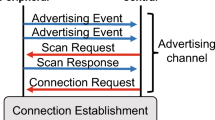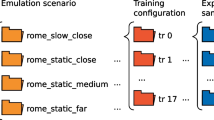Abstract
Ultra-dense networks (UDNs) are considered as key 5G technologies. They provide mobile users a high transmission rate and efficient radio resource management. However, UDNs lead to the dense deployment of small base stations (BSs) that can cause stronger interference and subsequently increase the handover management complexity. At present, the conventional handover triggering mechanism of user equipment (UE) is only designed for macro mobility and thus could result in negative effects such as frequent handovers, ping-pong handovers, and handover failures on the handover process of UE at UDNs. These effects degrade the overall network performance. In addition, a massive number of BSs significantly increase the network maintenance system workload. To address these issues, this paper proposes an intelligent handover triggering mechanism for UE based on Q-learning frameworks and subtractive clustering techniques. The input metrics are first converted to state vectors by subtractive clustering, which can improve the efficiency and effectiveness of the training process. Afterward, the Q-learning framework learns the optimal handover triggering policy from the environment. The trained Q table is deployed to UE to trigger the handover process. The simulation results demonstrate that the proposed method can ensure the stronger mobility robustness of UE that is improved by 60%–90% compared to the conventional approach with respect to the number of handovers, ping-ping handover rate, and handover failure rate while maintaining other key performance indicators (KPIs), that is, a relatively high level of throughput and network latency. In addition, through integration with subtractive clustering, the proposed mechanism is further improved by an average of 20% in terms of all the evaluated KPIs.









Similar content being viewed by others
References
Calabuig D, Ternon E, Venkatasubramanian V, Maternia M, Barmpounakis S, Gimenez S, Kousaridas A, Lakshmana TR, Lorca J, Lunden P, Ren Z, Sroka P (2017) Resource and mobility Management in the Network Layer of 5G cellular ultra-dense networks. IEEE Commun Mag 55(6):162–169
The 3GPP Organizational Partners (2020) Radio Resource Control (RRC) protocol specification, document TS 38.331. https://portal.3gpp.org/desktopmodules/Specifications/SpecificationDetails.aspx?specificationId=3197
Li Y, Cao B, Wang C (Apr. 2016) Handover schemes in heterogeneous LTE networks: challenges and opportunities. IEEE Wirel Commun 23(2):112–117
Zhou Y, Shen C, Van Der Schaar M (2019) A non-stationary online learning approach to mobility management. IEEE Trans Wirel Commun 18(2):1434–1446
Park HS, Lee Y, Kim TJ, Kim BC, Lee JY (2018) Handover mechanism in NR for ultra-reliable low-latency communications. IEEE Netw 32(2):41–47
Tayyab M, Gelabert X, Jantti R (2019) A survey on handover management: from LTE to NR. IEEE Access 7(1):118907–118930
Nguyen MT, Kwon S, Kim H (2018) Mobility robustness optimization for handover failure reduction in LTE small-cell networks. IEEE Trans Veh Technol 67(5):4672–4676
Alhammadi A, Member GS (2020) Auto tuning self-optimization algorithm for mobility management in LTE-A and 5G HetNets. IEEE Access 8:294–304
Da Costa Silva K, Becvar Z, Frances CRL (2018) Adaptive hysteresis margin based on fuzzy logic for handover in Mobile networks with dense small cells. IEEE Access 6:17178–17189
Xiong Z, Zhang Y, Niyato D, Deng R, Wang P, Wang LC (2019) Deep reinforcement learning for mobile 5G and beyond: fundamentals, applications, and challenges. IEEE Veh Technol Mag 14(2):44–52
Lu H, Li Y, Mu S, Wang D, Kim H, Serikawa S (2018) Motor anomaly detection for unmanned aerial vehicles using reinforcement learning. IEEE Internet Things J 5(4):2315–2322
Lu H, Liu Q, Tian D, Li Y, Kim H, Serikawa S (2019) The cognitive internet of vehicles for autonomous driving. IEEE Netw 33(3):65–73
Zhang Y, Li Y, Wang R, Hossain MS, Lu H (2020) Multi-aspect aware session-based recommendation for intelligent transportation services. IEEE Trans Intell Transp Syst:1–10
Lee C, Cho H, Song S, Chung J (Mar. 2020) Prediction-based conditional handover for 5G mm-wave networks: a deep-learning approach. IEEE Veh Technol Mag 15(1):54–62
Chaudhuri S, Baig I, Das D (2017) Self organizing method for handover performance optimization in LTE-advanced network. Comput Commun 110:151–163
T. Goyal, S. Kaushal (2019) Handover optimization scheme for LTE-Advance networks based on AHP-TOPSIS and Q-learning. Comput Commun 133:67–76. https://doi.org/10.1016/j.comcom.2018.10.011
Mwanje SS, Schmelz LC, Mitschele-Thiel A (2016) Cognitive cellular networks: a Q-learning framework for self-organizing networks. IEEE Trans Netw Serv Manag 13(1):85–98
K. Vasudeva, S. Dikmese, I. Guvenc, A. Mehbodniya, W. Saad, and F. Adachi, “Fuzzy logic game-theoretic approach for energy efficient operation in HetNets,” 2017 IEEE Int Conf Commun Work ICC Work 2017, pp. 552–557, 2017
Kwong CF, Chuah TC, Tan SW, Akbari-Moghanjoughi A (2016) An adaptive fuzzy handover triggering approach for long-term evolution network. Expert Syst 33(1):30–45
Wang Z, Li L, Xu Y, Tian H, Cui S (2018) Handover control in wireless systems via asynchronous multiuser deep reinforcement learning. IEEE Internet Things J 5(6):4296–4307
Chen MS, Wang SW (1999) Fuzzy clustering analysis for optimizing fuzzy membership functions. Fuzzy Sets Syst 103(2):239–254
The 3GPP Organizational Partners (2020) Study on channel model for frequencies from 0.5 to 100 GHz,document TR 38.901. https://portal.3gpp.org/desktopmodules/Specifications/SpecificationDetails.aspx?specificationId=3173
Bai Y, Chen L (2013) Hybrid spectrum arrangement and interference mitigation for coexistence between LTE macrocellular and femtocell networks. EURASIP J Wirel Commun Netw 1:2013
Vasudeva K, Simsek M, Lopez-Perez D, Guvenc I (2017) Analysis of handover failures in heterogeneous networks with fading. IEEE Trans Veh Technol 66(7):6060–6074
Suleiman KE, Taha AEM, Hassanein HS (2016) Handover-related self-optimization in femtocells: a survey and an interaction study. Comput Commun 73:82–98
Alhabo M, Zhang L (2018) Multi-criteria handover using modified weighted TOPSIS methods for heterogeneous networks. IEEE Access 6(c):40547–40558
Jiang F, Yuan Z, Sun C, Wang J (2019) Deep Q-learning-based content caching with update strategy for fog radio access networks. IEEE Access 7:97505–97514
Vasudeva K, Dikmese S, Guven I, Mehbodniya A, Saad W, Adachi F (2017) Fuzzy-Based Game Theoretic Mobility Management for Energy Efficient Operation in HetNets. IEEE Access 5:7542–7552
Acknowledgements
The authors acknowledge financial support from the International Doctoral Innovation Centre (IDIC), Ningbo Education Bureau, Ningbo Science and Technology Bureau, and the University of Nottingham. This study was also supported by the Ningbo Natural Science Programme, project code 2018A610095.
Author information
Authors and Affiliations
Corresponding author
Additional information
Publisher’s Note
Springer Nature remains neutral with regard to jurisdictional claims in published maps and institutional affiliations.
Rights and permissions
About this article
Cite this article
Liu, Q., Kwong, C.F., Wei, S. et al. Intelligent Handover Triggering Mechanism in 5G Ultra-Dense Networks Via Clustering-Based Reinforcement Learning. Mobile Netw Appl 26, 27–39 (2021). https://doi.org/10.1007/s11036-020-01718-w
Accepted:
Published:
Issue Date:
DOI: https://doi.org/10.1007/s11036-020-01718-w




